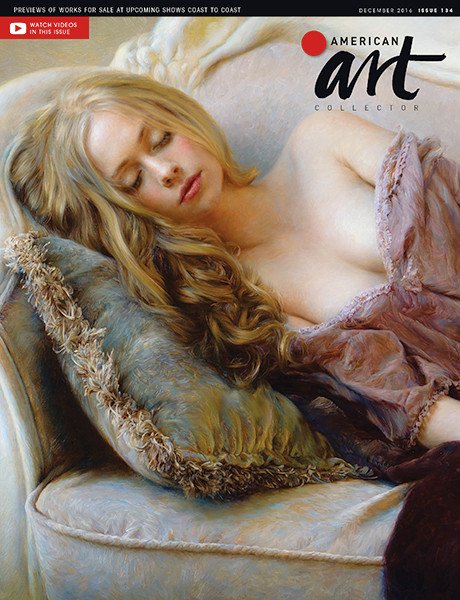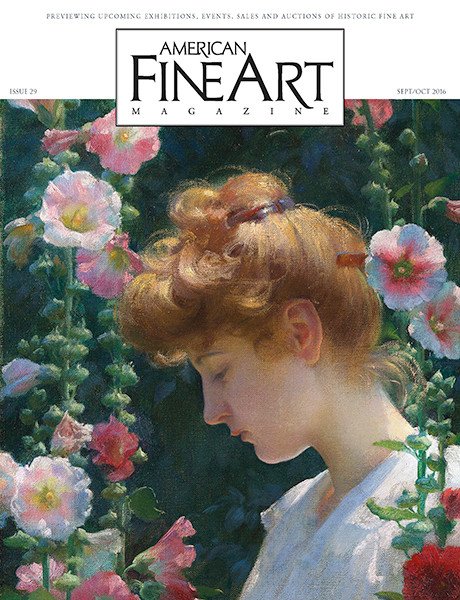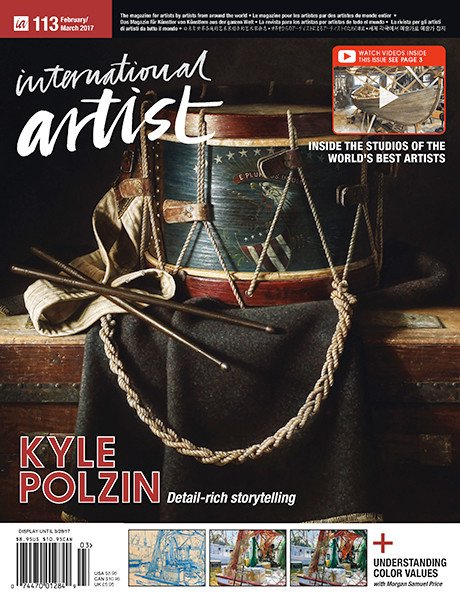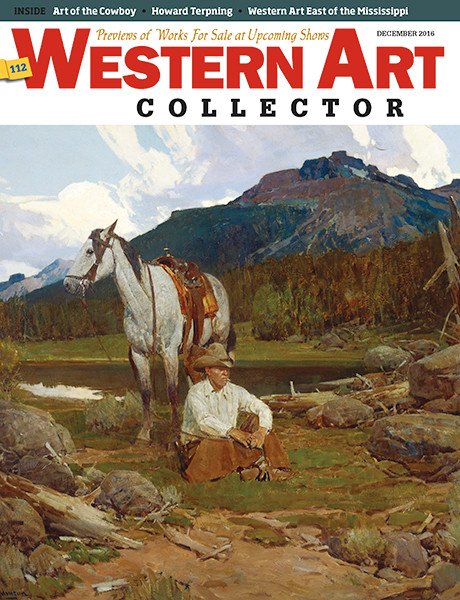Lukachukai Creek ran alongside Sheldon Harvey’s boyhood home on the Navajo Nation in northeast Arizona, nestled up against the Lukachukai Mountains. “I had a lot of freedom to explore outdoors,” he says. “Growing up there I used my imagination, putting stuff together at a very early age, playing with rocks in the creek and the wet sand under the cottonwoods. Later, at the local school I was introduced to art tradition. I didn’t excel in the studies. I was more attracted to making art, drawing from nature.”

Creation Story, acrylic on canvas
A member of the Red Running Into Water Clan of the Diné, he was trained as a medicine man by his grandfather and great-grandfather, but art kept calling him. “I recall as I got older, maybe third or fourth grade, I really felt this is something I’m gonna do. I’ve found something here. We had a room that was empty at home with a window facing west. I put a desk right in the middle of the room, and I knew that I was going to capture the last bit of evening light and I would just dive into blank sheets of paper. I curated the whole environment. The desk and chair had to be in the exact spot. As time lapsed and the sun went down and I couldn’t see any more, I would stop. It was time for supper. We didn’t have electricity and sunlight was important. In the process of doing it the first time, I thought there was something sacred about it. It was peaceful. I had the feeling I had to be an artist.”

Sheldon Harvey in his studio surrounded by paintings and carvings
Upon first deciding he’d have a career in the arts, Harvey began attending Diné College in Tsaile, Arizona. “I wasn’t really dedicated to being a student wanting to receive a degree. I was there to find myself,” he says. “I had no interest in general studies and gathered what I could from a few classes. I knew I could pursue this idea of being an artist. I felt a strong emotional experience, literally calling me and distracting me from my other classes. I wanted to get to work on creating.”
Initially, he was taught and encouraged by his uncle, Aaron Harvey, and his grandfather, Leo Harvey, a silversmith, as well as Videl Nez, at Diné College. He has also worked with Don Whitesinger and Tony Abeyta.

Crescentic Cave Markings, acrylic on canvas, 48 x 36 in.
Jumping ahead in his story, Harvey is now a full-time member of the faculty at Diné College sharing with his students the experiences of his 48 years of living and making art. “The students ask questions and they want to know everything from the basics to color theory and design practice. I work alongside them. When I see them apply what I’ve been teaching, there’s something about it. It makes me fulfilled.”
His successful career has not always been fulfilling. He relates, “I went to all the galleries on Main Street in Scottsdale and was denied. That hit my ego. I drove back up to Window Rock to deal with my first dose of reality. That was the moment I decided I’m not going to give up. I’m going to accept it and grow. When I decided that, it was the first time I felt a purpose. It ignited something inside of me.”

Untitled, mixed media on wood
In 2008, at SWAIA Santa Fe Indian Market, he hit the jackpot. His sculpture Twins won best of classification and his painting Trixter Way won best of classification and best of show, the only triple win anyone can remember. His work is now in collections around the world.
When I asked Harvey about pursuing perfection, he reminded me there is no word for perfection in Navajo. “The main element of life is to live in balance,” he says. “The Navajo word hózhó means balance, harmony, beauty. The practice for all of us as human beings is living in harmony and balance, the practice that will carry us through.

Carvings in various stages of completion in the artist’s studio.
“Perfection was given to the spirit in the beginning of creation. Everything was available but slowly, different elements were lost. A lot of our language and history is unknown. It’s natural to lose. But we have the power to preserve our language and culture now and to preserve our planet.
“We have an appreciation for humanity and the understanding that we learn from our past experience and look forward to the future...finding a pathway to create for the sake of the earth and for the sake of humanity. We understand the past enough to recreate and redesign. We have the idea that we are barely nicking the idea of life but have so much potential—observing, learning, growing. I see my work as part of the process.”

Fire Dancer II, acrylic on canvas, 60 x 50 in.
Harvey’s work is especially distinctive for his use of vivid color. “I was always afraid of color,” he admits. “I didn’t know how to mix a color. I was looking for immediate results. In my 20s I learned to take it step by step. That transformed my way of thinking, having more patience and giving myself more time. When it came to sand painting, there wasn’t much mixing of colors, the color was already there. And crayons were already created.”
In his painting Creation Story, he explains that his use of “pointy, sharp edges, triangles and rectangles called for more color intensity.”

Trickster, acrylic on canvas, 20 x 16 in. Images courtesy Faust Gallery.
The central figure in Creation Story is his interpretation of the Yei, the benevolent deity he learned about in his youth. When he was painting, he modified the intense colors to make the figure stand out.
“In the Navajo creation stories,” Harvey explains, “people evolved by making mistakes. Their failures led to the success of life continuing. In the Fifth World we’re now discussing the ideas of the atom, a nuclear presence and the power of the atom bomb. It’s not to say it’s the end. It’s moving to a new place where a rejuvenation will take place. Life will continue to grow.
“There’s a ritual I have before going into the studio. I meditate and visualize the places where spirit is, giving thanks. Giving thanks is the act of thinking about and being thankful for being able to wake up with my family, have a meal, for air, for water, for the sun—for the day and the night itself, for being alive in general. Giving thanks for being able to create.

Untitled, acrylic on canvas, 40 x 40 in.
“The works I’ve created have been a place where I can discover who I really am—a place where I can find peace and be free to imagine or create, free to discover more of the past of the Navajo people.
“I would like to say I’m still learning. This is endless. It excites me just to know I’ve come this far and still have a lot of years ahead, I pray. I’m still learning.” —
Sheldon Harvey will be at Booth No. LIN E 751. He also shows at Faust Gallery.
Powered by Froala Editor

















































































































































